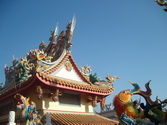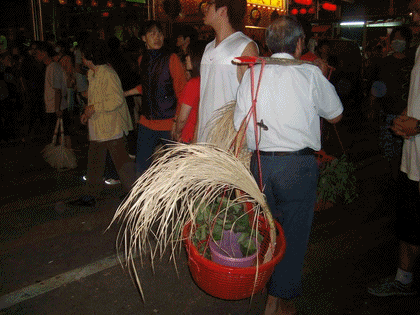
Blessing and Expiation
Expiation
Throughout that 3 days in Xigang Festival, you may see lots of people dressing in black, wearing restraints on their necks, sweeping street with brooms and waiting in patience all day long. They were not janitors, but average people who came to render or return votive wishes. They came for different purposes --- either themselves or member of their family were suffering in painĦBillness or misfortune. They supposed that they might commit certain sins. So by acting as convicts and cleaning passage for Wang Yeh, they'll expiate their sins and receive mercy from Wang Yeh.
7-Star Bridge
In Chinese mythology, the Seven Sages stars (astronomical stars of Big Dipper) were dominated by 7 divinities who determining the destiny of living beings. So in ancient China, the Taoism master erected 7-Star Bridge to stand for Seven Sage stars. The bridge starts with a dragon mouth as entrance and ends with a tiger mouth as exit. So people who attend this activity, have to pay NTD100 to get a pack of paper which represents participant him- or herself, then step on the bridge and walk through to the end. After participant stepping down the bridge, a Taoism priest would recite certain prayer to participant and took away the paper. By such activity it's said the participants would be exempt from misfortune or bad luck.
Contribution for military ration
It's said that celestial army was watching over the progress of festival all the time. So people may prepare fabric red bags, fill them up with grainsĦBbeansĦBsaltĦBsugarĦBoil and vinegar, which serve as military rations and dedicate them to celestial soldiers.
Tokens of Wang Yeh
Because there're 12 divinities taking turns as Wng Yeh to perform the duty, therefore no specific statue in Qing An temple to represent Wang Yeh. Hence committee of Qing An temple generated certain substantial tokens, in shape of trophy or carp, to symbolize Wang Yeh and allow believers to enshrine it in their house. So prior to Xigang Festival, all those believers would bring their tokens back to Qing An temple, in order to deposit them in ritual and share the spiritual power from Wang Yeh. Just like "recharge" the token with Wang Yeh's magic power every 3 years.

Bamboo poles
That seven bamboo poles erected in front of Qing An temple serves the same function as lighthouse. So divinities from the remote would be guided and landing on here. The area surrounding bamboo poles was like apron. So it may accumulate spiritual energy which radiated from divinities. People believed that if meandering between those bamboo poles, they'd receive spiritual energy from divinities.
Centipede Formation
Among those troupes who participated in Xigang Festival, Centipede Formation was no doubt the most eye-catching assemblage in procession. In ancient mythology, it's said that centipede possessed certain magic power, therefore such Centipede Formation would help to expel evil spirits away. The Centipede Formation looks like a roller coaster, which is a long trail resembling centipede, dragged by a light tractor in the front, with 66 uplifted seats linked one after the other. The children who were seated in Centipede Formation came from a small village in south part of Xigang.
Contribution of aqua and pasture
It's said that the celestial army assigned by Wang Yeh to supervise the progress of festival would station in Qing An temple from the beginning to the end. Therefore during that 3-day festival, you may see lots of people shoulder a yoke, carrying a bundle of pasture on one side and a bucket of aqua on the other side. Those pasture and aqua were contributed to the horses which were saddled for celestial army.